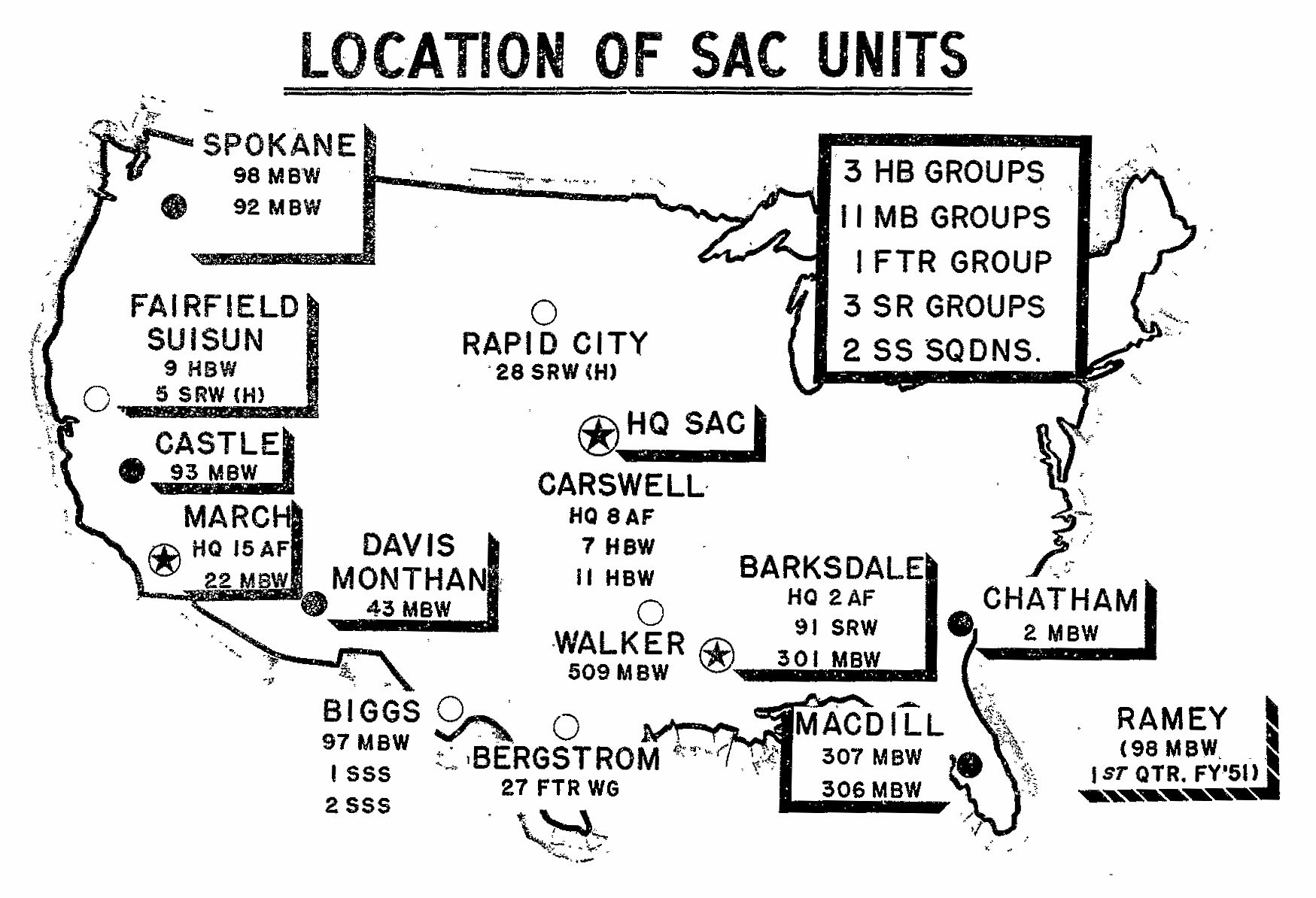
PRESENTATION
BY
THE
STRATEGIC AIR COMMAND
COMMANDERS
CONFERENCE
UNITED STATES AIR FORCE
RAMEY
AIR FORCE BASE
25-26-27 APRIL 1950
COPY NO #4 of 10 Copies
- - - - - - - - - - - - - - - - - - - - - - - - - - - - - - - - - - - - - - - - - - - - - - - -
TOP
SECRET
AUTH: CG, SAC
21 Apr 50
HEADQUARTERS
STRATEGIC
AIR COMMAND
COMMANDERS
CONFERENCE
UNITED STATES AIR FORCE
RAMEY
AIR FORCE BASE
25 - 26 - 27 April 1950
- - - - - - - - - - - - - - - - - - - - - - - - - - - - - - - - - - - - - - - - - - - - - - - -
AGENDA
RESOURCES
AND STATUS OF THE STRATEGIC
AIR COMMAND, OUTLINE OF THE WAR
PLAN,
AND DISCUSSION OF CURRENT SOFT SPOTS -
DIRECTOR OF
OPERATIONS
- - - - - - - - - - - - - - - - - - - - - - - - - - - - - - - - - - - - - - - - - - - - - - - -
General Vandenberg and Gentlemen:
In brief order I will cover the current operational plan for the atomic offensive and the present status of forces within the Command, Following this, General LeMay has asked that I point up the major deficiencies which impair, or threaten to impair, the execution of this plan.
Items to be discussed include:
Organization and location of units
Personnel
Aircraft
Plan of overseas movement
Planned disposition of deployed forces
Latest target system
First atomic strike
Notes on bombing accuracy
Current "soft spots"

As shown by this chart, Strategic Air Command is composed of the following:
Three (3) Heavy Bombardment Groups
Eleven (11) Medium Bombardment Groups
One (1) Fighter Group (with one additional group to be assigned in the near future)
Three (3) Strategic Reconnaissance Wings
Two (2) Strategic Transport Squadrons
These units are organized as follows:
Shown in green are units of the Fifteenth Air Force, commanded by General O'Donnell with headquarters at March Air Force Base.
Units of the Eighth Air Force shown by yellow are located in the central part of the country. The Eighth Air Force is commanded by General Ramey, with headquarters at Carswell AFB, Fort Worth, Texas.
In the eastern part of the country are located units of the Second Air Force. These units are shown in blue. General Atkinson commands the Second Air Force with, headquarters at Barksdale, Louisiana.
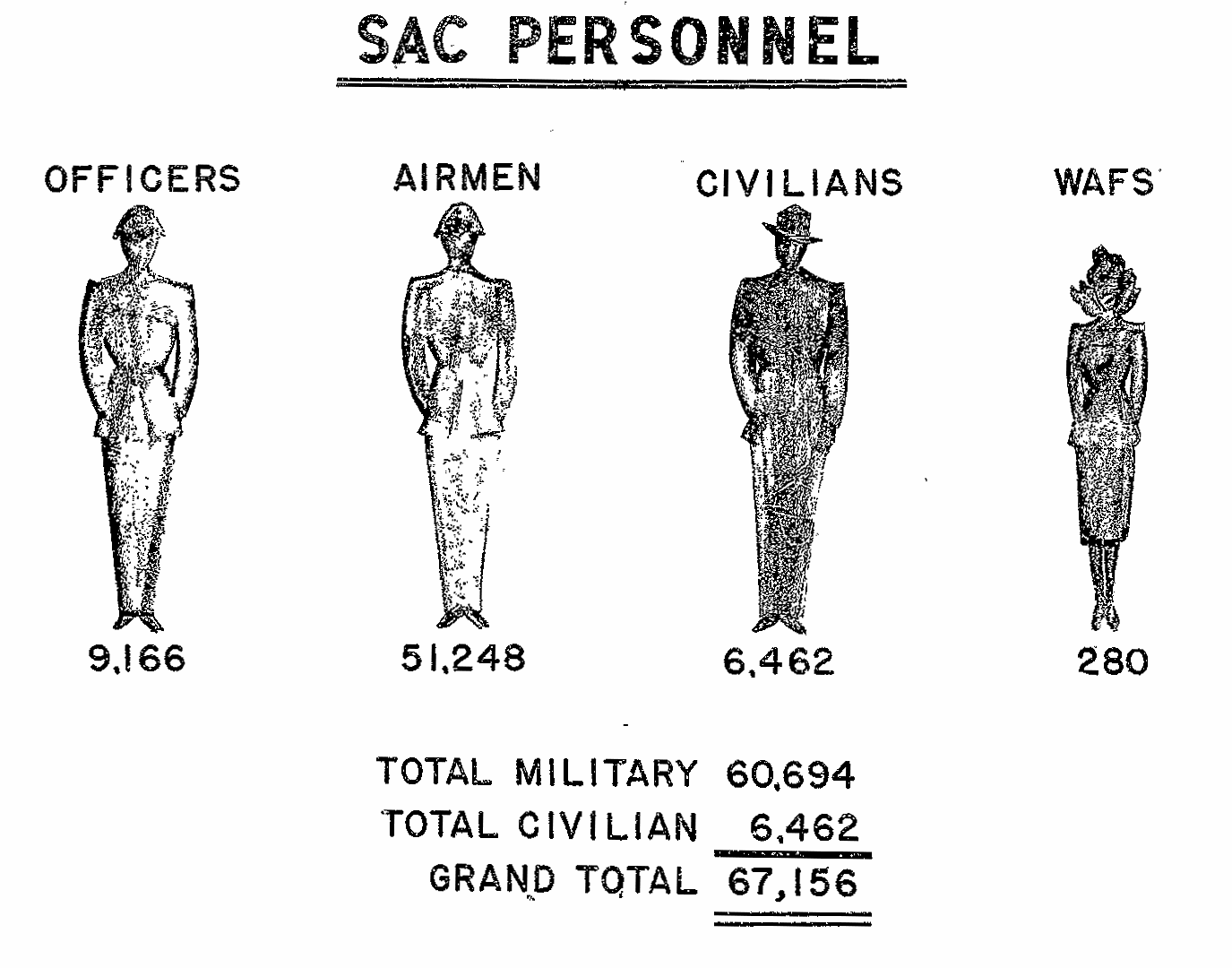
As shown by next chart, the command has a total personnel strength of 67,156, composed of:
9,166 Officers
51,248 Airmen
6,462 Civilians, and
280 WAFs
This amounts to approximately 16% of the total strength of the Air Force.
Although fully manned, body-wise, SAC is only 85% effectively manned.
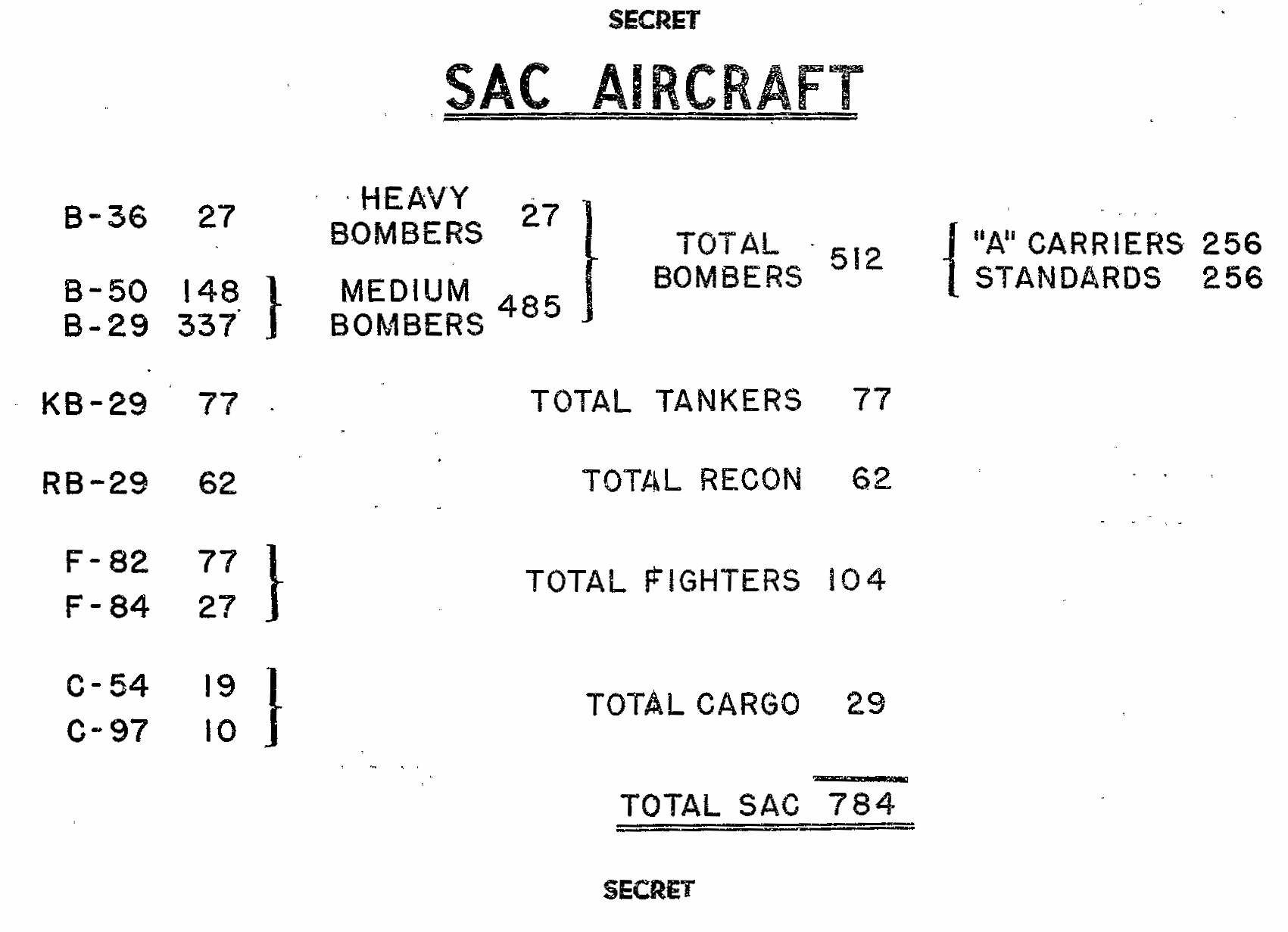
As for aircraft. exclusive of administration types, we have a total of 784, broken down as follows:
512 Bombers, including 27 Heavies and 485 Mediums (Note that the 485 Mediums consist of 148 B-50s and 337 B-29s)
Also note that of the 512 total, 50% are equipped to carry the A-bombs.
Our total tanker strength is 77. All of these are equipped with the British type refueling system.
Our total Reconnaissance strength is 62 . All of these are the B-29 type. We have not yet received our first RB-36 or our first RB-50.
At present we have 104 Fighters. With the assignment of the 31st Fighter Group, this figure will be approximately doubled.
In our Transport units we have a total of 29 aircraft.
So much for assigned aircraft.
(CHART)
At exercise "DUALISM," conducted at Maxwell Field in December 1948, we outlined in detail the plan for moving our forces overseas. Although the size of our deployment has changed, the general scheme of movement remains the same.
The present plan calls for rapid movement overseas of seven (7) Bomb Groups, one (1) Fighter Group, one (1) Reconnaissance Group, and five (5) A-Bomb Assembly Teams.
One additional Assembly Team goes to Alaska.
On E-Day only a limited number of movements occur, all of which are in the Zone of the Interior. The large scale movement starts on E+1 with the departure of the initial squadrons.
By E+3 the intensity of movements will reach its peak. To refresh your memory, I have a chart showing movements scheduled for E+3.
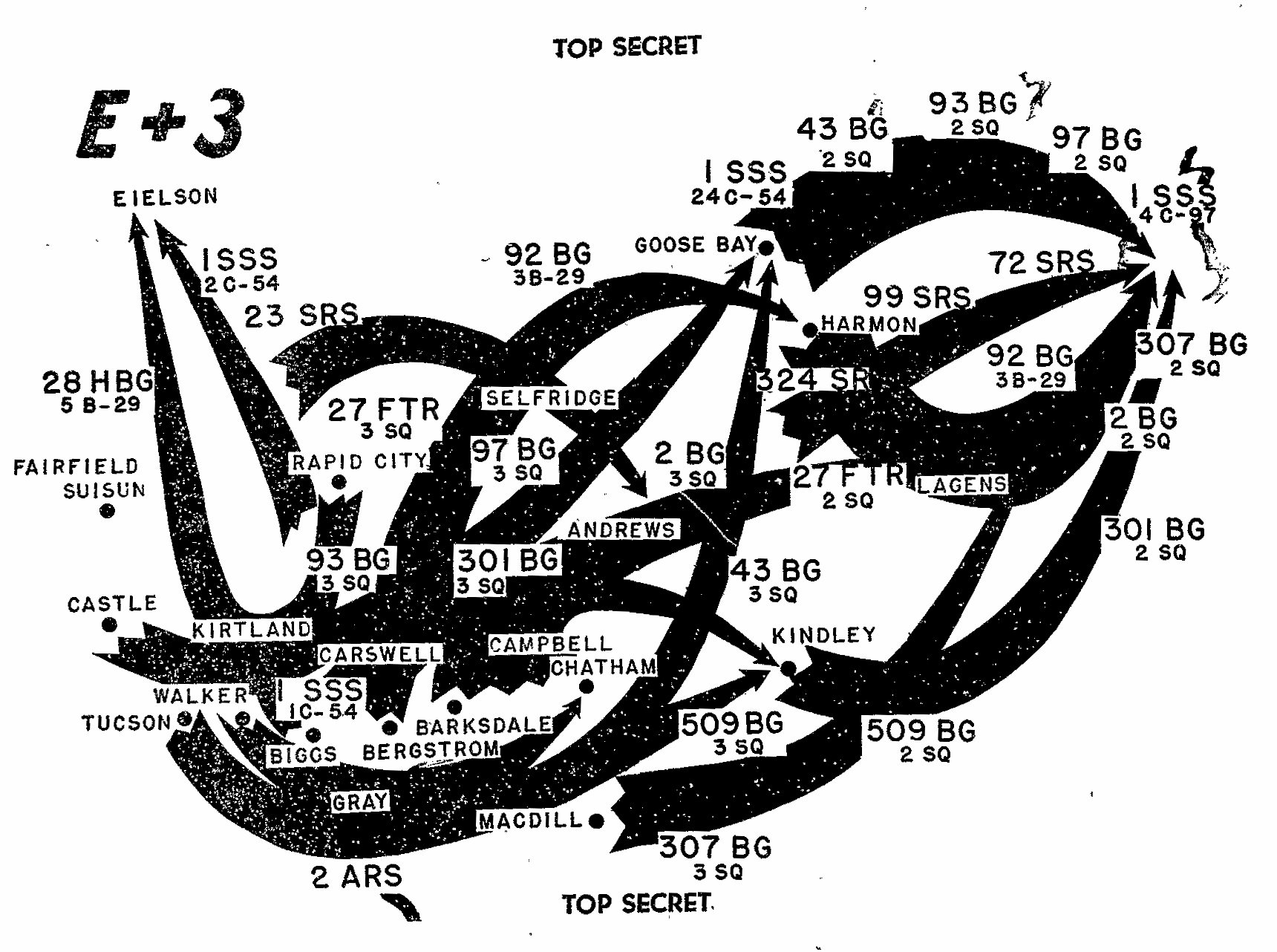
As shown by this chart the second squadrons of each deployed group are moving into position in the United Kingdom; the third squadrons are shown departing home stations for staging bases. Staging bases includes Goose Bay, Harmon, Selfridge, Andrews, Kindley, and Lagens. Tactical aircraft will be routed through storage sites to pick up A-Bombs and components.
En route to Alaska-five (5) B-29s from Rapid City carrying A-Bomb components, and two (2) C-54s carrying assembly team personnel and equipment.
By E+5, all movements are scheduled to be completed.
(CHART DOWN)
Our plan calls for the utilization of eight (8) air bases in the United Kingdom, The disposition on these air bases is shown by the next chart.

Fairford - the 2d Group with 30 B-50s, 10 tankers and 15 B-29s, and Assembly Team 5.
(Note: A-Bomb carriers are shown in red.)
Upper Heyford - the 307th Group with 33 B-29s.
Brize Norton - two groups, the 93d with 45 B-5Gs, the 97th with 15 B-50s, and Assembly Team 3.
Lakenheath - the 301st with 30 modified B-29s, 18 tankers, 15 B-29s, and Assembly Team 2.
Sculthorpe - the 43d Group with 33 B-50s, 20 tankers, 12 B-29s, and Assembly Team 1.
Marham - 509th Group with 33 modified B-29s, 20 tankers, 12 B-29s, and Assembly Team 4.
Bentwaters - the 27th Fighter Group with 81 F-84ES and and F-82s.
Heathrow - the 5th Reconnaissance Wing with 43 RB-29s. The total force will consist of 349 bombers, 48 reconnaissance, and 81 fighter aircraft for a grand total of 478.
As mentioned previously, Assembly Team No. 6 will be deployed to Alaska, to handle bombs for the B-36 staging operation.
(CHART DOWN)
As for targets, plan "TROJAN" listed a total of 70 industrial centers. Plan "OFF TACKLE" lists a total of 123,
With the target material we now have, we are prepared to strike 60 of the 123 targets, Pre-strike reconnaissance is required on the remaining 63. The location of targeted and un-targeted areas is shown by the following chart.
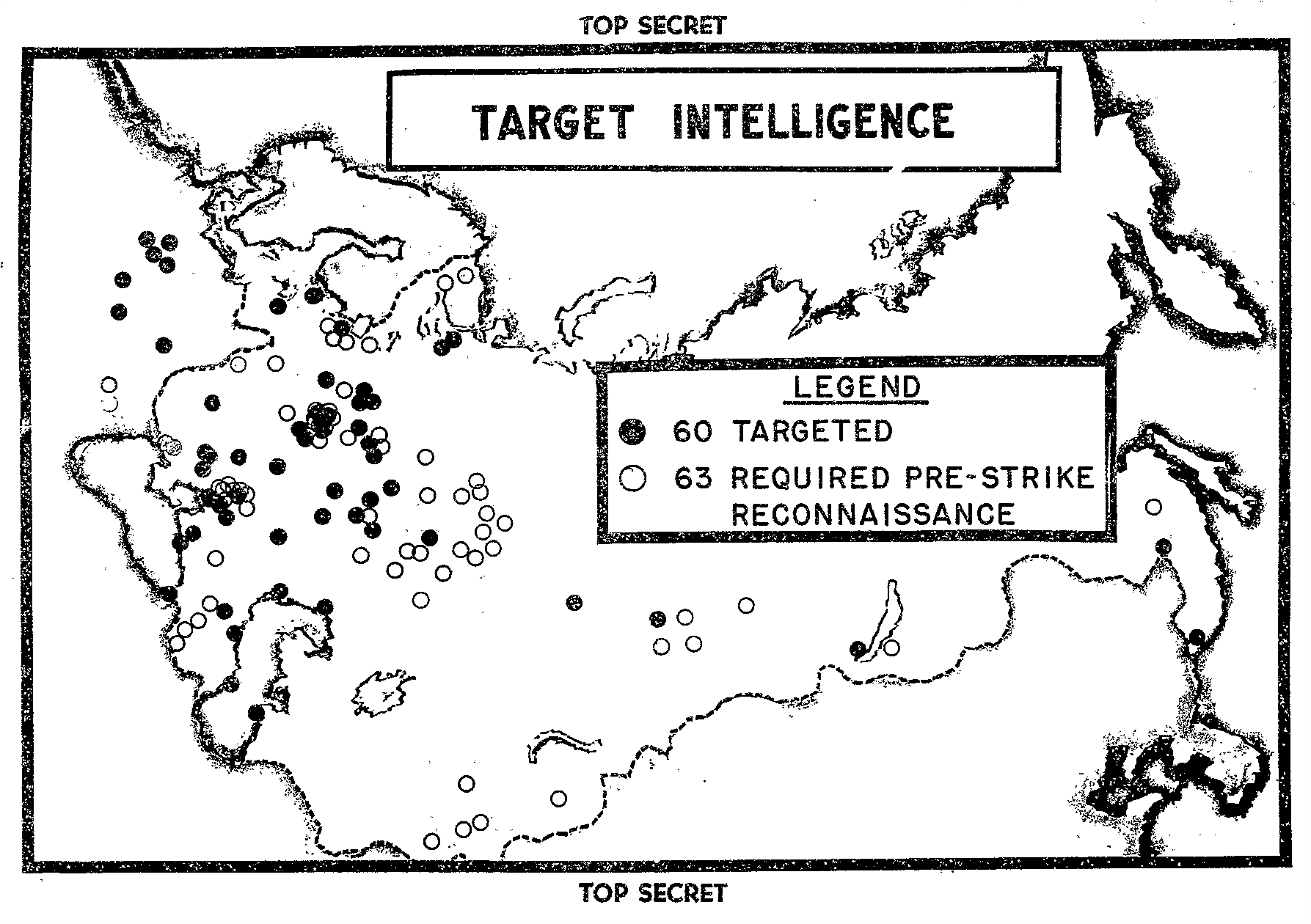
Red discs indicate areas on which we now have target material, and blank discs indicate areas which will require pre-strike reconnaissance.
The magnitude of the reconnaissance effort can be appreciated by noting the numbers of untargeted areas and their geographical spread. Several of the target areas assigned by "OFF TACKLE" lie outside the boundaries of Russia proper.
(CHART DOWN)
The first atomic strike is scheduled to be launched on E+6.
Medium bombers will attack from the United Kingdom and B-36s will attack from either Alaska, Goose Bay, or Rapid City. In the event that B-36s are launched from Rapid City, it will, of course, be necessary to stage them through the Middle East, Experience to date indicates that, with present facilities at Eielson, we will not be able to operate B-36s through Alaska during mid-winter when temperatures are below about -30°.
The next chart shows the scheme of attack for medium bombers based in the United Kingdom, Let me emphasize that this is only the first strike, involving a total of 26 target areas. Also let me point out that it is only one way of conducting the strike. There are, of course, many variations involving the size of the force as well as tactics to be employed.
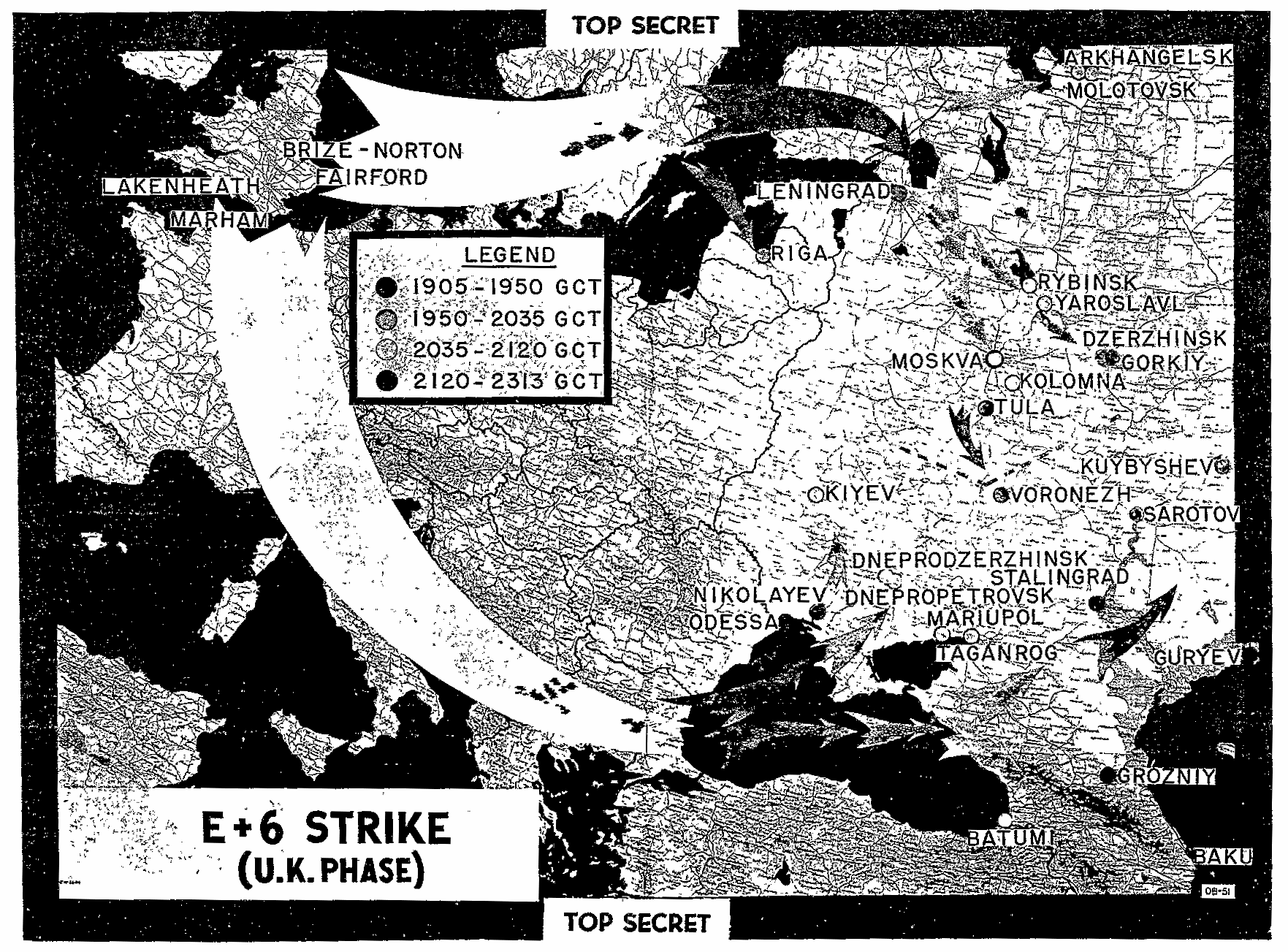
The attack plan calls for Soviet borders to be penetrated simultaneously by two major forces attacking from the northwest and southwest.
The total force will include 201 UK-based medium bombers and 10 North American-based B-36s. Only the UK phase is shown on the chart. 112 will attack along the northern route and 89 along the southern route. The northern force will approach along Southern Scandinavia and Southern Finland, the penetration occurring in the area northeast of Leningrad. The southern forces will cross Central France, Central Italy, the Southern Balkans, and will penetrate along the Black Sea area.
We have resorted to color to show the scheme of maneuver by indicating successive positions of the two forces as the attack develops.
For instance, at the time that the northern force is crossing Southern Scandinavia, the southern force will be crossing Greece.
During the period 1905-1950, GCT, forces will be positioned as shown by brown. At this time, borders will be crossed and periphery targets bombed.
During the period 1950-2035, the forces will be positioned as shown by the blue areas. Seven targets will be bombed during this period.
During the period 2035-2120, positions are shown by green. Five targets will be bombed.
The most remote targets, totalling ten, will be struck during the period 2120-2333, as shown by the red.
Within approximately four hours after borders are crossed, all targets will have been bombed.
We have not attempted to indicate the withdrawal routes. However, forces attacking targets north of the dotted Red line will withdraw to the United Kingdom; while those attacking targets south of the line will withdraw to staging bases in the Middle East.
We believe that this general scheme of attack will give us the maximum degree of saturation in so far as fighter defenses are concerned.
To dilute AA defenses as much as possible, we plan to compress each attacking cell to approximately one minute between successive aircraft. A cell will normally comprise from two to four supporting bombers and one A-carrier.
Simultaneous with the United Kingdom strike, B-36s are scheduled to strike six targets from North American bases, making a total of 32 targets included in the first strike.
It is also planned to dispatch reconnaissance aircraft against untargeted areas during this first strike.
The timing of later strikes will be determined by the tactical situation. However, we plan to launch the second strike not later than E+9. If United Kingdom bases remain tenable, it is planned to complete strikes against 123 targets within a period of 30 days.
(CHART DOWN)
Since exercise "DUALISM," much interest and effort has been devoted to the problem of bombing accuracy. Many questions have been asked concerning the capability of our crews to hit assigned targets. The Weapons' System Evaluation Group has. completed an intensive study of our capability, and has rendered a favorable report.
As a matter of information, General LeMay asks that I review quickly the progress we have made during the past year on radar bombing accuracy.
Before presenting actual figures, a few words on the background of this problem.
During the past year, we have conducted a number of evaluation exercises designed to measure bombing accuracy capability. These exercises consisted of radar bombing runs against a variety of industrial areas within the United States. Ground radar units were used to track the bombers and measure bombing accuracy.
All attacks were conducted at 25,000 feet and above. In addition, a system of "first runs" was instituted, a "first-run" being the initial approach on any one day against a particular target. This was done to isolate and eliminate the advantage gained through successive runs.
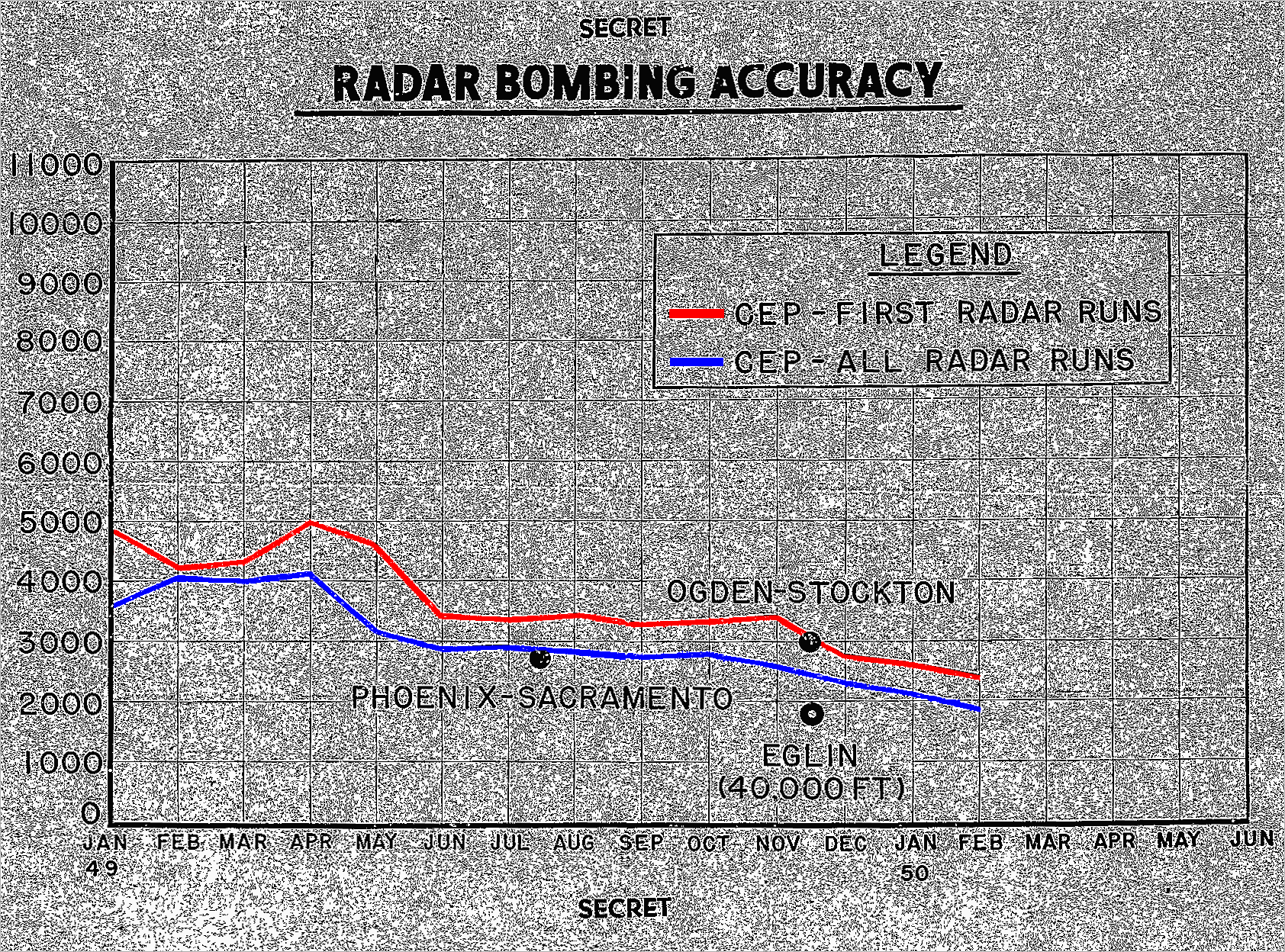
As shown by this chart, the trend of all SAC first runs has dropped from around 5000 feet last year to a present level of around 2500.
In all radar runs, including practice runs, the error has fallen from approximately 4000 feet to 1800.
During the early part of 1949, we experienced some rather high bombing errors in the neighborhood of from eight to ten thousand feet. Close scrutiny indicated that these high errors were due to faulty techniques, poor mission preparation, and lack of experience at high altitudes on industrial type targets.
Accordingly, an intensive training program, both air and ground, was instituted on the subject of radar bombing.
It also became apparent that especially selected crews would have to be ear-marked as A-carriers and subjected to intensive training. This was done and a Lead Crew School was established for this purpose.
In the summer of 1949 an exercise was conducted utilizing lead crews. A number of missions were run against Phoenix and Sacramento, producing an average CEP of about 2500 feet.
In the winter of 1949, the final two exercises were conducted against Ogden and Stockton. One hundred and fifty nine first runs produced an average error of around 3000 feet. For this exercise all SAC crews were scheduled. Note that the results confirm the accuracy trend line.
Also a controlled experiment was conducted by SAC and APG, utilizing B-36s at 40,000 feet altitude. With the improved Q-24 equipment, B-36 crews were able to average 1,925 feet for a total of 114-radar runs. Targets included Eglin, Tampa and Birmingham.
Our Lead Crew School is still in operation and is being used to train evaluated crews selected as A-carriers. This will be a continuing program. By careful screening of A crews, by continued training, and with improved bombing equipment, such as the Q-24 and K series, we believe that bombing accuracy can be improved below the 2000 foot level.
With a weapon radius of 5000 feet, we are confident that targets can be accurately bombed.
Approximately 18,000 radar runs, all conducted above 25,000 feet, provide the basis on which these figures were based.
So much for bombing accuracy.
(CHART DOWN)
The foregoing gives a brief picture of SAC resources and the planned utilization of those resources, in the event of an emergency. You can appreciate the need for a high degree, of readiness and preparation, if the Plan is to be carried out on schedule. There are a number of deficiencies which threaten to impair, to varying degrees, its execution.
CURRENT “SOFT SPOTS”• ADVANCED BASES• RECONNAISSANCE• FIGHTERS• AIRLIFT AVAILABLE FOR DEPLOYMENT• ECM• ELECTRONICS MAINTENANCE PERSONNEL• MATERIEL |
Current deficiencies include:
Advanced Bases
Reconnaissance
Fighters
Airlift available for deployment ECM
Electronics Maintenance Personnel and Materiel
On the subject of Advanced Bases;
You will recall that the recent plan contemplates the use of eight (8) Air Bases in the United Kingdom and two (2) staging bases in the Middle East. For discussion, I will use a chart previously shown.

The three bases in the Oxford area - Fairford, Upper Heyford and Brize Norton, have runways of only 6000 feet in length. These are inadequate for B-29 operations and extremely marginal for B-50s. The use of these bases in the immediate future would necessitate staging a number of sorties through the eastern bases. Although arrangements are under way for lengthening- the runways, considerable time will be required before the work is completed.
So far as runways are concerned, Lakenheath, Sculthorpe, Marham and Heathrow are satisfactory.
Bentwaters has 6000-foot strips which are inadequate for F-84Es, operating with four external tanks.
Base personnel complements are now considered adequate for Lakenheath. Sculthorpe and Marham, However, none are available for the additional bases at present.
Essential base equipment is in place only at Lakenheath, Sculthorpe and Marham.
Plans for base defenses and ground security are not satisfactorily developed. AA-defense is limited to only a few 50 calibre guns and no concrete plans have been developed for fighter cover and ground troops for protection against sabotage.
Avgas distribution is a problem. Fuel lines connecting tank farms with operating bases are not currently in use. Until pipe lines are activated, it would be necessary to resort to rail and motor transportation, .with obvious disadvantages.
The RAF now plans to station approximately 70 B-29s at Marham which complicates present, deployment plans.
As for Dahran and Cairo areas, the basic difficulties include a shortage of on-base fuel storage at Dahran and the lack of firm air base defense plans for both areas.
(CHART DOWN)
The next soft spot is reconnaissance. The picture can be summed up briefly.
Although three reconnaissance wings are presently programmed, we now have the equivalent strength of one wing, and, considering the basic equipment of this wing, the RB-29, we are stretching a point to assess our present strength as the equivalent of one wing. Looking at the job required by OFF TACKLE, we estimate that at least four reconnaissance wings would be required on a minimum basis.
The accomplishment of such essential photography as pre-strike and post-strike missions would required approximately 750 sorties. In the event of an early emergency, it would be necessary to draw heavily on the bomber forces to supplement the effort of our present reconnaissance forces.
As for .post-strike reconnaissance, the tactical difficulties involved in operating RB-29 aircraft during daylight hours are obvious. The RB-47 will greatly alleviate the bomb-damage assessment problem, but the airplanes will not be with us in numbers until early 1953.
So much for reconnaissance. Next is the matter for fighters.
Since this discussion involves fighter-escort over routes to target areas, I will call your attention to the strike plan chart.

We require fighter escort protection along both, principal routes the northern route along Southern Scandinavia and the southern route across France. These routes are critical inasmuch as daylight .passage is unavoidable during a large part of the year. Also, because of the long range involved, our bombers must operate at medium altitudes over these approach routes.
In addition to close escort, we need fighter cover over UK bases during critical periods of loadings and take-offs.
The entire job, if accomplished efficiently, would call for four fighter groups. At present, we have one group assigned, and one additional group to be assigned in the near future. These groups are to be equipped with F-84E type aircraft. A test program, utilizing four external tanks, is soon to be conducted. Based on the results of this test, we will submit requirements for long range fuel tanks. However, at present there are no stocks of long range fuel tanks in the United Kingdom.
In summary, we have no long range fighter escort capability at present. Inasmuch as escort groups will be required for a period of only 30 to 45 days, it is felt that some arrangement could be worked out to provide them. After this time they could be reassigned for other duty.
Airlift available for deployment.
The present emergency plan calls for approximately 360 C-54 equivalent sorties to be accomplished by E+8. Staff discussions with MATS indicate that they can provide approximately 260 during this period. We are therefore examining the situation to determine how much of this deficit can be made up by using B-29s. Use of the relatively small bomber force for airlift during this period is. undesirable: for many obvious reasons.
An exercise designed to test SAC-MATS mobility is scheduled for June. MATS will provide 126 C-54 equivalents, which will permit us to exercise movements scheduled for the first four days.
Electronics Counter Measures
The present war plan calls for the use of Chaff and electronic jammers. We plan to use B-29s to support the atomic carriers by strengthening our ECM effort and by diluting enemy defenses.
Our present ECM capability is about 35% effective. This condition is due to a shortage of electronic jammers, a type of Chaff that is not altogether suitable, and the fact that automatic Chaff dispensers are not yet installed so that they can be operated from pressurized compartments. Steps have been taken to improve the overall ECM picture but months will be required to achieve any material improvement. The next item is Electronics Maintenance Personnel.
Although the command is fully manned - body-wise - we are not 100% effectively manned.
Certain critical shortages continue to hamper operations the most critical being electronics maintenance personnel.
In this category, the command is a little over one half manned. Steps have been taken to train out all present personnel shortages however, some categories will not be completely filled until late 1951.
The last "soft-spot" is Materiel.
In January we presented to the Air Staff the major engineering and supply problems which then confronted us in the conversion of our units to new types of aircraft. These deficiencies were consolidated in these two documents. Some of the problems presented at that time have since been solved or partially solved; however, there are still many confronting us.
A few of our major engineering problems have been:
In connection with the B-50, major engineering and maintenance difficulties have been encountered with the turbo superchargers and the electrical system.
With the B-36, the major deficiencies fall in four categories; power plant, fuel leaks, radar and armament.
In addition we have various items limiting operations with B-29, KB-29, F-86 and F-84 aircraft.
Our supply support problems have not been greatly alleviated since the January presentation. We are still plagued with an excessive number of B-50 and B-36 critical spares, a serious lack of current supply and maintenance publications and critical shortages of personnel and survival equipment. These supply deficiencies, of course, add up to an unsatisfactory situation insofar as supply support is concerned.
In closing let me emphasize that I have by no means covered all the problems facing the Command. There are many others of somewhat less importance than those covered.
They have all been assembled and made known to appropriate agencies.
Also, may I emphasize that I have discussed only those deficiencies which face us today. As the enemy builds up his atomic capability, the mission of the Command, and its ability to execute its mission, will be basically affected.
General LeMay will cover this part of the presentation.